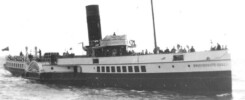
The Golden Eagle was built in 1909 by John Brown & Co on the Clyde for the General Steam Navigation Company’s services on the Thames from Fresh Wharf, next to London Bridge, down river to Margate and Ramsgate where she can be seen in the above picture.
Although many excursion paddle steamers were taken over by the Government in the First World War to be fitted out for a military role, others, particularly some of the larger ones like the Golden Eagle with their ability to shift large numbers of people, were called up as troopships. The Golden Eagle left the Thames on 18th February 1915 for Southampton, amidst a threat of German submarines about to blockade British ports, where she was inspected by Government officials and, after a few small alterations had been made, was declared fit for service.

Her first trip was from Southampton to Rouen on 23rd February with 685 troops and 12 officers aboard after which she was regularly in service ferrying troops to and from Le Havre, Rouen, Boulogne, Calais, Dunkerque, Southampton, Dover, Folkestone, Cowes and Felixstowe.
Unusual diversions from her staple trooping included, on 13th March 1915, conveying 569 German prisoners of war, who had been captured at Neuve Chapelle, from Rouen to Southampton under guard from 75 men and 2 officers of the Border Regiment. On 13th August 1915 sailing from Dover to Dunkerque with 119 officers and men of the then recently formed Royal Naval Air Service (RNAS) together with their cargo of six small aeroplanes including one which was credited with shooting down the first Zeppelin. And sailing from Dover to Cowes on 20th April 1916 to transport a two and a half ton double engined seaplane with a wingspan of 100ft and two more, on 12th July 1916, from Cowes to Felixstowe.
On 31st August 1918 the Golden Eagle was ordered to London to be Commissioned and fitted out for a new role as a minelayer but by the time she was ready the Armistice had been signed so she reverted to her previous occupation as troop transport on 4th December 1918 running between Folkestone and the French ports for another year until decommissioned in November 1919.
Overall during her war service she carried 618,101 troops covering a distance of 32,140 miles during which she consumed 12,839 tons of coal. Amongst those she carried were 6,329 Chinamen, 6,000 USA troops, 2,794 British repatriated prisoners of war and 3,998 hospital patients. There is not a record of the number of troops she took out but did not bring back.
One thing which surprised me in this list of statistics was the 6,329 Chinamen. Chinamen? What were Chinamen doing being sent on the Golden Eagle to the battle front? Well my initial thought that perhaps they had some special role in the laundry section turns out to be well short of the mark. Digging (so to speak!) further I have discovered that the Chinese Labour Corps (CLR) were sent to war with picks and shovels rather than rifles to play a major role in digging trenches, building fortifications, maintaining fighting vehicles and repairing roads, railways and bridges often under enemy fire. Around 95,000 Chinese farm labourers were recruited from their remote villages in China into the CLR to work for Britain during the war from 1916 after escalating losses of British troops led to a dearth of labourers to do the spade work at the front. The Chinese travelled across the Pacific to Canada by sea, over that country on sealed trains to avoid paying any landing dues and then across the Atlantic to Britain from where they were shipped off from Folkestone to France and Belgium where they were housed in labour camps and put to work ten hour days, seven days a week.
When the war was over and other men had gone home the Chinese continued their efforts until 1920 clearing the battlefields and burying the dead in the newly built cemeteries. Their contribution was barely recognised at the end of the war. There is no tribute to them on any British war memorial and they have no descendants in the UK as they were refused any right to settle after the war. They have truly been described as the “forgotten of the forgotten”.

After the war the Golden Eagle returned to her previous incarnation moving happy holiday makers and day trippers down the Thames from London to Margate and Ramsgate and, apart from further escapades during the Second World War during which she was an Auxiliary Anti-Aircraft Vessel (pictured above), continued to do so right up to 1951.
My thanks to Terry Lilley for researching Golden Eagle’s wartime itinerary.
Kingswear Castle returned to service in 2023 after the first part of a major rebuild which is designed to set her up for the next 25 years running on the River Dart. The Paddle Steamer Kingswear Castle Trust is now fund raising for the second phase of the rebuild. You can read more about the rebuilds and how you can help if you can here.
John Megoran


